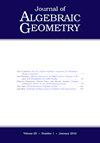小坂维度的数值概念不一致
IF 0.9
1区 数学
Q2 MATHEMATICS
引用次数: 15
摘要
设$X$是一个光滑的投影变量。除数$D$的Iitaka维数是一个重要的不变量,但它不仅取决于$D$的数值类。然而,有几种“数值Iitaka维”的定义,仅取决于数值类。在本文中,我们证明存在一个伪有效的$\mathbb R$除数,其中这些不变量取不同的值。关键是构造一个伪有效的$\mathbb R$-除数$D_+$的例子,其中$h^0(X,\lfloor m D_+ \rfloor+ a)$上下以$m^{3/2}$的倍数为界,对于任何足够充裕的$ a $。本文章由计算机程序翻译,如有差异,请以英文原文为准。
Notions of numerical Iitaka dimension do not coincide
Let $X$ be a smooth projective variety. The Iitaka dimension of a divisor $D$ is an important invariant, but it does not only depend on the numerical class of $D$. However, there are several definitions of ``numerical Iitaka dimension'', depending only on the numerical class. In this note, we show that there exists a pseuodoeffective $\mathbb R$-divisor for which these invariants take different values. The key is the construction of an example of a pseudoeffective $\mathbb R$-divisor $D_+$ for which $h^0(X,\lfloor m D_+ \rfloor+A)$ is bounded above and below by multiples of $m^{3/2}$ for any sufficiently ample $A$.
求助全文
通过发布文献求助,成功后即可免费获取论文全文。
去求助
来源期刊
CiteScore
2.70
自引率
5.60%
发文量
23
审稿时长
>12 weeks
期刊介绍:
The Journal of Algebraic Geometry is devoted to research articles in algebraic geometry, singularity theory, and related subjects such as number theory, commutative algebra, projective geometry, complex geometry, and geometric topology.
This journal, published quarterly with articles electronically published individually before appearing in an issue, is distributed by the American Mathematical Society (AMS). In order to take advantage of some features offered for this journal, users will occasionally be linked to pages on the AMS website.

 求助内容:
求助内容: 应助结果提醒方式:
应助结果提醒方式:


